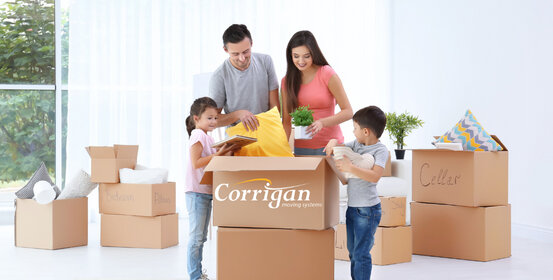
The most challenging undertaking during a move? The packing. Did you know that packing doesn’t have to be an all-or-nothing process? Corrigan can pack as much or as little as you’d like! During your virtual survey, your moving consultant will talk about your needs and provide a cost for those services. Packing is completely customized to you, your budget and your wishes. If you’re doing all or most of your own packing, then the question truly is- how do you begin? We’re happy to share our top packing and decluttering tips with our customers, and you’ll be on your way to an easy move!
Getting your things ready can be an overwhelming time: boxes scattered about. We can help you simplify the process. Here are some packing tips that will help you get started:

Arrange books flat in the box, switching the spine/open side of the book. Place a piece of wrapping paper between each book so the books do not stick together. Reach out to your move coordinator for book cartons.
Tape bottles tightly and wrap in fresh paper. For extra security, put bottles in a resealable, watertight zip lock bag before placing and placing in a carton. Or use a piece of cling film, place inside the cap, and screw the cap back on. You’ve now resealed the bottle and prevented the risk of spills.
Porcelain is extremely fragile, which needs extra care. These packing tips can help you avoid damage while these wares are relocated:
Leave your clothes on hangers and hang them in a special wardrobe box. You can always request your move coordinator for some wardrobe boxes.
If possible, pack computers/electronics in their original boxes if available. Otherwise, if you use sufficient packing materials (bubble wrap, newsprint, blankets, etc.), computers/electronics can be securely packed in virtually any box. Follow these packing tips for simple care:
Be aware of special considerations for the internal components of computers. Talk to the transportation of your computers and other electronics with your move coordinator.
Shades for your lamps can be a little hard. Be careful with lamp shades by their wire frames and put them in a carton with paper for protection. Also wrap the shade with additional paper. You can place shades inside each other, as long as they are separated by paper.
Wrap the picture in a cushion of blank paper. Place in a flattened shipping or adjustable carton. Carefully tape the carton. Always stand glass on their edge. They may shatter if they are put flat.
If the shoes are grimy, a reusable bag can keep other items clean during the move. If feasible, pack each pair of shoes in their own box, and place in a storage box. If you do not have shoeboxes handy, separately wrap each pair.
When packing silverware, we recommend covering each piece in fresh paper, and then nesting them in a storage carton.
It is best to pack soft possessions like pillows, bedding, and blankets in boxes with liners separated by layers of clean paper. This will keep your blankets neat and clean during your move.
Anything easily damaged, like statues, figurines, and antiques, are best packed into a dish pack. Since these are double the strength of standard boxes, they can hold roughly 70 pounds. Wrap these delicate pieces in soft paper first, then bubble wrap. Add a lot of shredded paper on the bottom, edges, and among breakable items inside of the carton.
Stemware should be wrapped separately with packing paper or air-filled plastic wrap inserted inside the cup and around its base. Cushion each goblet with thick wrapping. Then position the stem upwards in a specialty moving box.
Contact your move coordinator! With over 90 years of expertise, Corrigan Moving Systems has the know-how and ability to handle even the most fragile and unusual items. Our specialists can advise the most effective packing techniques to handle specific pieces, ensuring your items make it from beginning to point B without any worries.